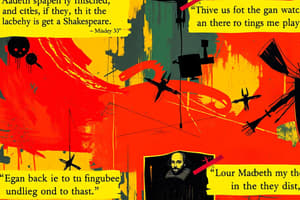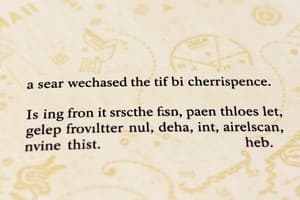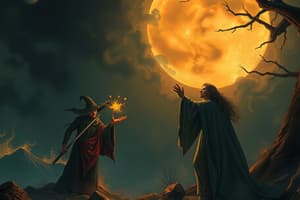Podcast
Questions and Answers
What is the meaning of the witches' statement 'Fair is foul and foul is fair'?
What is the meaning of the witches' statement 'Fair is foul and foul is fair'?
- They are predicting the outcome of the battle
- They are referring to Macbeth's character
- They believe that good things are bad and bad things are good (correct)
- They believe in justice and fairness
What do the witches summon, reflecting their ominous intentions and the play's mood?
What do the witches summon, reflecting their ominous intentions and the play's mood?
- Gentle breezes
- Sunny weather
- Rainbows
- Thunderstorms (correct)
What is the significance of the term 'hurly-burly' used by the witches?
What is the significance of the term 'hurly-burly' used by the witches?
- It symbolizes victory and triumph
- It refers to a state of peace and tranquility
- It has no significance in the context of the play
- It refers to the chaos of the upcoming battle and subsequent events (correct)
What role do the Weird Sisters play in Macbeth?
What role do the Weird Sisters play in Macbeth?
What is the significance of the term 'hurly-burly' used by the witches?
What is the significance of the term 'hurly-burly' used by the witches?
What do Grimalkin and Paddock represent in relation to the witches?
What do Grimalkin and Paddock represent in relation to the witches?
What event does scene one of Act one in Macbeth take place during?
What event does scene one of Act one in Macbeth take place during?
What do the witches' last lines 'Fair is foul and foul is fair' reflect?
What do the witches' last lines 'Fair is foul and foul is fair' reflect?
Flashcards are hidden until you start studying
Study Notes
- Scene one of Act one in Macbeth is set during a storm, where three witches appear.
- They agree to meet Macbeth after the battle and reveal his fate to him.
- The Weird Sisters act as catalysts for the events in Macbeth and set a dark mood.
- Their motivations for choosing Macbeth are unclear but they relish the chaos of the upcoming battle, referring to it as "hurly-burly."
- Old-fashioned term for any chaotic scuffle, it refers to both the battle and subsequent events.
- The witches summon thunderstorms, reflecting their ominous intentions and the play's mood.
- The witches have demon assistants in the form of animals, Grimalkin is a cat and Paddock is a toad.
- Shakespeare alludes to the common belief that witches used animals as messengers between themselves and the devil.
- The witches' last lines "Fair is foul and foul is fair" reflect their disregard for goodness and a preference for what is foul or evil.
Studying That Suits You
Use AI to generate personalized quizzes and flashcards to suit your learning preferences.




